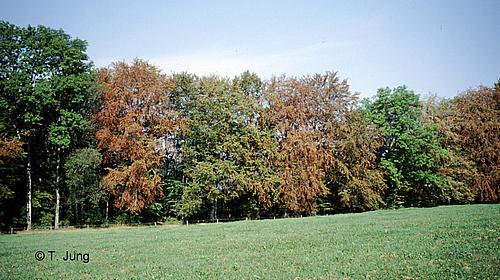Source(s):
- Kim Coder, Warnell School of Forestry, The University of Georgia.
- Gil Landry, Center for Urban Agriculture, The University of Georgia.
- Bob Polomski, Extension Consumer Horticulturist, Clemson University.
- Debbie Shaughnessy, HGIC Information Specialist, Clemson University.
Shade is a wonderful benefit of trees but a major challenge for growing turfgrass. Although growing grass under trees is difficult, there are some important tree and turfgrass management principles involved in successful coexistence. Basic management practices for growing grass under shaded conditions consist of proper turfgrass selection, cultural practices, pest management, environmental modification, and traffic control.
Shading below 55% of full sun or about 4 hours of sunlight per day can initiate many low light related problems. The lack of sufficient sunlight reaching the grass causes a reduction in photosynthesis, which is the process that produces energy for growth. As a result, lawn grasses have lower tolerance to heat, cold, disease, drought and wear stress.
Competition with trees and shrubs for limited nutrients and water also reduces vigor, as many shrubs and trees will have root growth in the same area as the grass roots. Disease problems are often more severe in shade due to higher humidity, reduced air circulation, and prolonged dew retention. As a result of these factors, turfgrass grown in the shade often begins a steady decline in density, especially as trees and shrubs mature.
Turfgrass Selection
Certain turfgrasses perform better in shade than others. Of the cool-season grasses, tall fescue is a common choice in Georgia. Fine fescues may perform well in some situations. Of the warm-season grasses, St. Augustine grass exhibits the best tolerance to shade. Recommended St. Augustine grass cultivars for the coastal and midstate areas include Raleigh, Palmetto and Mercedes. Zoysiagrass is more tolerant to light or moderate shade than centipedegrass, but neither will survive heavy shade. Zoysiagrass cultivars that have good tolerance to shade include El Toro and Cavalier. Meyer has fair tolerance, while not much is known of the relative shade tolerance of Empire. Bermudagrass exhibits extremely poor tolerance to any shade.
It is important to remember that fine and tall fescue are adapted to north Georgia, while dependent on the variety, zoysiagrass, centipedegrass, and bermudagrass can be grown throughout the state.
When establishing cool-season grasses, it is best to seed or sod early enough in the fall so there is sufficient time for the turfgrass to mature before leaves cover the ground. During the fall remove leaves by raking, blowing or bagging when mowing to prevent smothering of the grass. Cool-season turfgrasses will grow long after deciduous trees have dropped their leaves.
Cultural Management
- Raise the mowing height to the highest recommended height. This increased leaf area helps the plant capture more sunlight and thus manufacture more “plant food”.
- Nitrogen needs for turfgrasses are generally 50% lower in shaded environments than recommended for full sun. This generally means no more than one to two pounds of nitrogen per 1000 sq. ft. per year. This should reduce lush growth which is more prone to disease problems and temperature and drought stress. Since most turfgrasses and trees require the same amounts of fertilizer, soil testing should be used to determine lime and fertilizer needs. Surface applications of fertilizer are generally preferred for trees and turfgrasses. Concentrating fertilizer in holes, especially if holes are deeper than five inches, is not recommended. Finally, fertilizer or fertilizer plus herbicide should never be placed directly on exposed tree roots.
- Irrigate deeply and infrequently to encourage deeper rooting and to reduce the humidity and time the grass leaves are moist. Since moist conditions encourage disease, irrigate in early morning.
- Remove tree leaves, grass clippings, and any other debris that might prevent light penetration or encourage disease activity.
- Follow a good pest management program to reduce competition from weeds, and injury from diseases and insects. In shade environments, preemergence herbicides are not typically needed for weeds like crabgrass and goosegrass, which are full sun plants that generally do not grow in low light conditions. However, this class of herbicides may be effective against other weeds that can grow in the shade. Read and follow label directions that are printed on the product.
- Control traffic to reduce wear injury. The added stress of traffic can easily cause the loss of grass in shaded areas.
Pest Management
Most of the same disease problems exist in both shady and sunny areas. Those diseases associated with high moisture and/or high humidity may be more serious in shady areas because air movement is reduced and surface moisture remains longer. Proper cultivar selection and turfgrass management practices are key to reducing the severity of these diseases.
Environmental Management
Ornamentals that have dense canopies and shallow roots normally make turfgrass survival difficult even if proper management practices are used. When possible, select trees and shrubs that are deep-rooted and have relatively open canopies. Some species that generally cause fewer problems include sycamores, many oaks and most elms. Undesirable species include ash, willow, poplar and some species of maples.
Some measures can be taken to aid grass survival, whether desirable or undesirable ornamentals are present. Selectively prune branches, particularly low branches, to aid in air movement and light penetration. Ideally, the lowest branches of trees should be more than 8 feet above the soil surface. Remove any unnecessary trees and shrubs. Use recommended species and sufficient spacing between plants when placing new plants.
Consider other alternatives if quality grass cannot be maintained, even after following sound management practices and using recommended species and varieties. Two options you may consider are:
- Removing ornamentals;
- Planting an appropriate shade-tolerant groundcover — such as English ivy, ajuga, liriope and pachysandra rather than a turfgrass.
For additional information on turfgrass management, visit the University of Georgia turfgrass webpage.
Resource(s): Lawns in Georgia
Center Publication Number: 205




